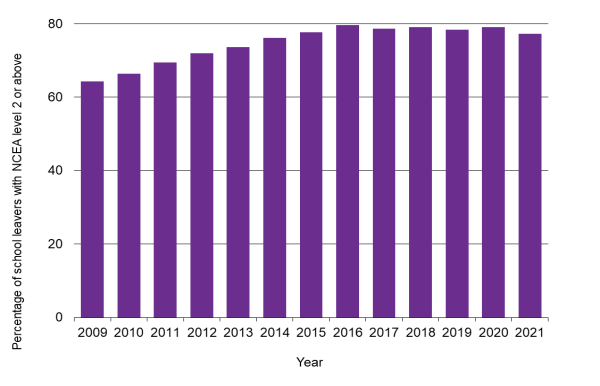Educational attainment

 EDUCATIONAL ATTAINMENT
EDUCATIONAL ATTAINMENT
| IMPROVING TREND |
Educational attainment levels for people in the Waikato region peaked in 2016 and while falling since then, remain high relative to historical levels.
This indicator is the percentage of school leavers with NCEA level 2 or above, from Ministry of Education records.
Why is this indicator important?
Upper secondary school qualifications, currently NCEA level 2, serve as the foundation for higher (post-secondary) learning and training opportunities as well as the preparation for direct entry into the labour market. Those that leave education early with few qualifications are at much greater risk of unemployment or vulnerability in the labour force, and are more likely to have lower incomes, and fewer employment opportunities than those with higher qualifications.
Educational attainment

| Year | Percentage of school leavers with NCEA Level 2 or above |
| 2009 | 64.2 |
| 2010 | 66.4 |
| 2011 | 69.5 |
| 2012 | 72.0 |
| 2013 | 73.6 |
| 2014 | 76.1 |
| 2015 | 77.6 |
| 2016 | 79.6 |
| 2017 | 78.6 |
| 2018 | 79.1 |
| 2019 | 78.3 |
| 2020 | 79.1 |
| 2021 | 77.2 |
Note: Historical time series retrospectively updated each year by Ministry of Education.
What is this indicator telling us?
- Over the period 2009 to 2016, there was a strong upward trend in the percentage of school leavers with NCEA level 2 or above, and this measure remained high in 2021 relative to historical levels despite disruptions due to the COVID-19 pandemic.
- The Ministry of Education and the New Zealand Qualifications Authority (NZQA) introduced a range of responses to NCEA to support students during the pandemic. In 2021 this included additional supports in the Auckland, Tai Tokerau and Waikato regions in recognition of a higher degree of disruption in these regions.
- A higher percentage of females than males achieve NCEA level 2 or above, and educational attainment remains lower for Māori school leavers compared to other ethnic groups at the regional and national level.
- There is considerable variation throughout the Waikato region for this indicator. In 2021, the percentage of school leavers with NCEA level 2 or above ranged from a low of around 62 per cent in the Waitomo District up to 82 per cent in the Hauraki District. These local level figures can change considerably from year to year.
- According to latest results from the Programme for International Student Assessment (PISA), New Zealand’s reading, mathematical and science literacy scores were all above the OECD average for PISA 2018. There was no significant difference in New Zealand’s performance in reading, mathematical and science literacy from PISA 2015, however the long-term trend shows a decline in scores.
- Latest results from the Progress in International Reading Literacy Study (PIRLS) show that for New Zealand’s Year 5 students in 2020, their attitudes to reading and their reading confidence both appear to have somewhat waned over the five-year period since 2015. According to the PIRLS results, Year 5 students were more positive about their digital prowess than they were about their reading.
- Latest results from the Trends in International Mathematics and Science Study (TIMSS) show that for New Zealand’s Year 5 students in 2018/19:
- Average mathematics achievement was similar to 2014 but higher than 1994, and average science achievement remained similar to prior years.
- Average mathematics achievement was significantly higher than 15 countries but lower than 38 countries. Average science achievement was significantly higher than 23 countries but lower than 31 countries.
DATA SOURCE AND SUPPORTING INFORMATION
Data are updated annually on the Ministry of Education’s Education Counts website (school leavers).
Update details: Updated online in July each year. Data for each year may be retrospectively updated to account for prior school leavers returning to get qualifications; data quality improvements; and changes to data methodology and definitions.
Customised data request requirements: Nil
DATA AVAILABILITY – OTHER THAN WAIKATO REGION:
Territorial Authority (TA) disaggregation: Yes
Other regions: Yes
New Zealand: Yes
Other countries/ Organisation for Economic Co-operation and Development (OECD): Comparable survey data on learning trends in young people are available including the Programme for International Student Assessment (PISA), the Progress in International Reading Literacy Study (PIRLS) and Trends in International Mathematics and Science Study (TIMSS). Data on the academic attainment level of the adult population are less comparable between countries.




To ask for help or report a problem, contact us
Tell us how we can improve the information on this page. (optional)